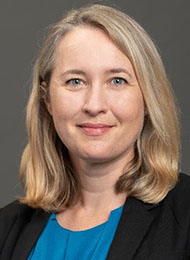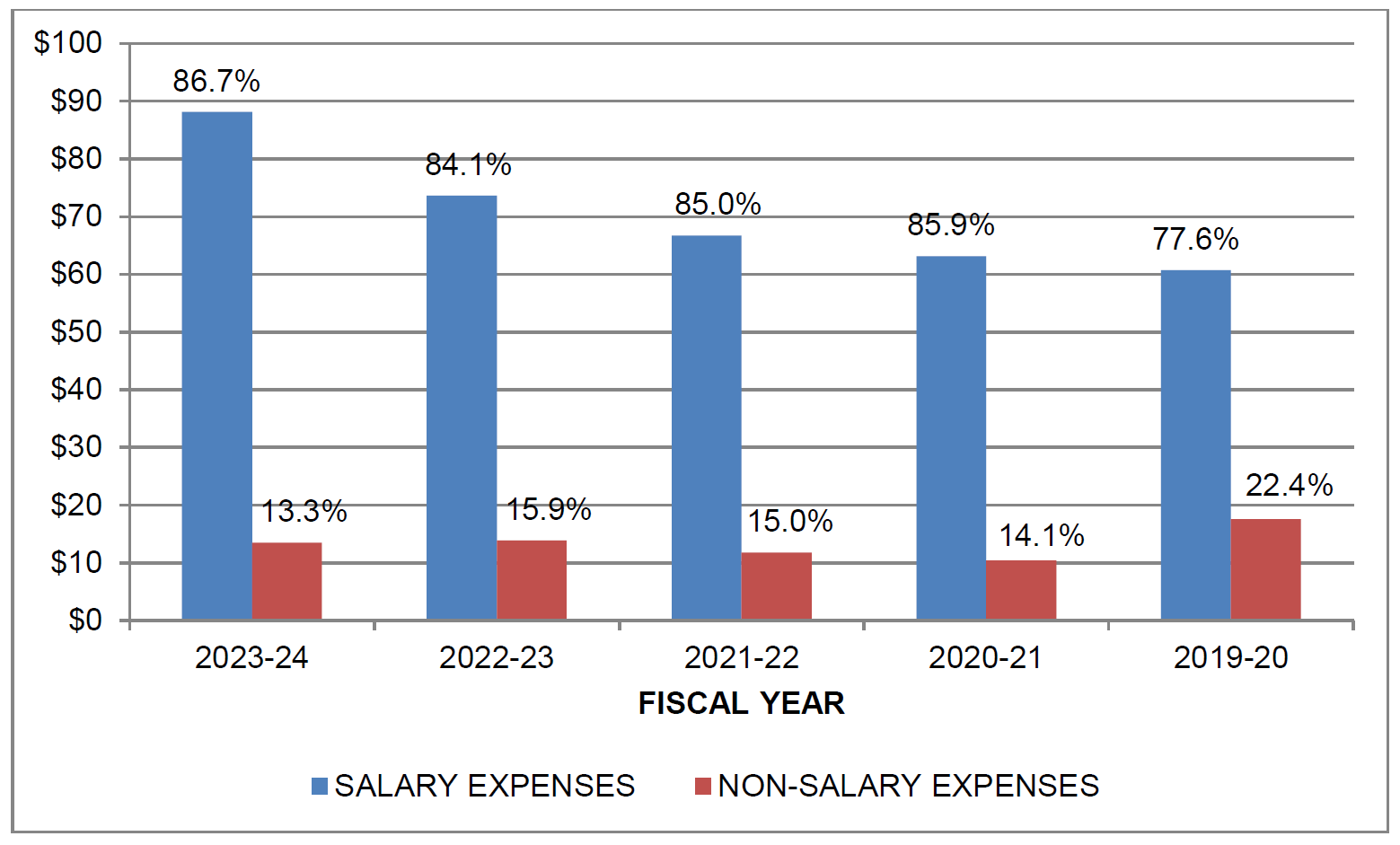Canadian Institutes of Health Research Annual Report 2023–24
Content
- Chair's Message
- Providing Stewardship and Accountability
- Financial Statement Discussion and Analysis
- Financial Statements
- Independent auditor's report
Message from the Chair of CIHR Governing Council

Dr. Marie-Josée Hébert
Chair, CIHR Governing Council
On behalf of Governing Council, I am pleased to present the 2023-2024 Annual Report of the Canadian Institutes of Health Research (CIHR), the Government of Canada's health research funding agency.
The previous year's accomplishments highlight CIHR's pivotal role in championing and advancing the pioneering endeavors of Canada's health research community. Through the agency's investments, collaborative partnerships, and steadfast support, it fosters an environment that is conducive to innovation and excellence, propelling Canada's health research landscape to new heights of discovery and impact. Concerted efforts, grounded in dedication to excellence, have positioned the agency to contribute substantively to the pursuit of finding evidence-based solutions to our most pressing health challenges.
This annual report illustrates CIHR's significant progress in service of its CIHR Strategic Plan 2021-2031. Looking ahead, I hold great optimism about the future of Canada's health research ecosystem as the agency continues to advance each of its five priorities and its commitment to organizational excellence.
Advance Research Excellence in All Its Diversity
Key progress this year includes the establishment of a new CIHR Advisory Committee on Ethics to advise on ethical considerations in health research, guiding CIHR's commitment to ethics principles as outlined in the CIHR Act. Among other things, it will offer advice on ethics priorities in health research, provide direction for embedding ethics considerations into CIHR's operations, and identify and address emerging ethics issues in health research contexts.
Enhancing collaboration is an important strategy to advance these efforts, therefore, I am pleased to share updates on several key collaborative initiatives.
For example, through collaborative efforts with CIHR's tri-agency partners, the Natural Sciences and Engineering Research Council (NSERC) and the Social Science and Humanities Research Council (SSHRC), CIHR continued to work towards the goal of equal and full participation of highly qualified researchers, including through Budget 2022 investments to increase the number of scholarships and fellowships available to Black scholars. CIHR also collaborated with tri-agency partners to explore a policy shift towards requiring immediate open access to agency-funded research publications, ensuring that valuable research findings are freely available, fostering transparency, and accelerating the dissemination of knowledge. When finalized, this policy will reinforce CIHR's commitment to promoting translation of evidence into policies, technologies, and health-related standards, increasing the impacts of the research that CIHR funds.
CIHR also joined Research on Research Institute (RoRI), whose mandate is to help funders and other key players transform research systems and cultures to deliver on the full potential of research. This represents a significant opportunity to work in partnership with tri-agency partners and leverage international expertise to improve how research is funded, carried out, communicated, and evaluated.
Finally, this year, CIHR proudly joined the G7 Cancer initiative as a founding member. Joining this important global initiative, led by the French Institut national du cancer, marks an important step in strengthening cooperation among cancer research funders around the world and enhancing global knowledge sharing.
Strengthen Canadian Health Research Capacity
One of CIHR's goals is to enrich the health research community by promoting diversity in perspectives, expertise, and experiences.
In line with this aim, this year, CIHR proudly announced its glossary of terms on accessibility and systemic ableism, a significant accomplishment that underscores its commitment to fostering inclusivity and helping to address systemic barriers in health research. Drawing from the Government of Canada's Accessible Canada Act (2019) and the Guide on Equity, Diversity, and Inclusion Terminology, this comprehensive glossary provides a standardized framework for discussing and addressing accessibility and ableism issues both within and outside of the agency.
This year marked a significant milestone as CIHR announced the results of Canada's first Research Excellence, Diversity, and Independence (REDI) Early Career Transition Award. By providing recipients with resources and opportunities needed to transition to the next stage of their careers, this award celebrates excellence while fostering a more inclusive and dynamic research landscape, driving innovation and discovery for the next generation of health researchers.
As part of the agency's ongoing efforts to support the development of interdisciplinary, inter-jurisdictional, and intersectoral research training platforms, CIHR launched a second Health Research Training Platform. This important investment is intended to support the development of structured, openly available, diverse, inclusive, and sustainable training and mentoring platforms that build Canadian capacity in areas of health research, health issues, scientific opportunities and critical gaps. Further in line with the agency's priority to strengthen Canadian health research capacity, the investment will support the development of skills that increase the likelihood of employability and career prospects of diverse trainees and early career researchers across these sectors.
Finally, this year, a funding partnership with the Coalition for Epidemic Preparedness Innovations (CEPI), resulted in a significant investment towards accelerating vaccine development projects. CIHR's share of this $9.9 million investment bolsters its commitment to strengthening Canadian health research capacity by cultivating expertise and innovation in vaccine science within Canada, positioning Canada's research community as a global leader in pandemic preparedness and response research.
Accelerate the Self-Determination of Indigenous Peoples in Health Research
CIHR, NSERC and SSHRC are working to establish a common set of principles and guidelines to better understand the complexities of Indigenous citizenship and membership, and ensure that funding opportunities intended for Indigenous researchers are available to them. This year, collaborative efforts culminated in the release of What We Heard: A Report from the Three Federal Research Funding Agencies' Ad Hoc Working Group on Indigenous Citizenship and Membership. This important report reflects Indigenous (First Nations, Inuit, and Métis) perspectives gathered through engagements with Indigenous and post-secondary partners in 2023. The resulting strategy's implementation will be guided by the Indigenous Leadership Circle in Research.
CIHR is also pleased to report productive collaborative efforts with tri-agency partners through the efforts of a Working Group on Administrative Barriers to Indigenous Community-led Research. Through this Working Group, the agencies aim to improve access to research funding through three distinct initiatives. First, by expanding funding eligibility to Indigenous individuals at community-based organizations, second, by introducing a process for Indigenous organizations to become eligible to administer agency research funds, and third, by providing indirect cost support to Indigenous community-based organizations.
For CIHR, impactful strategic initiatives developed by and with Indigenous Peoples remains a high priority. CIHR is pleased to have launched the 5-year renewal of the Network Environment for Indigenous Health Research (NEIHR) Program and the Yukon Centre Development Grant. These grants will continue building on key achievements made by the existing nine NEIHR Centres and NEIHR National Coordinating Centre while addressing the existing gap of the program in the regional reach.
CIHR is pleased to report its efforts towards expanding CIHR staff knowledge on meaningful engagement with First Nations, Inuit and Métis Peoples, both through internal training and development of the Indigenous Engagement Resource Toolkit to interact with Indigenous Peoples, communities, and partners in a culturally appropriate way.
Pursue Health Equity Through Research
CIHR continued its efforts to ensure that new evidence enhances the care and health outcomes of women, girls, and gender-diverse individuals by announcing the results of a competition to support high risk, high reward research in high-priority areas of women's health research as part of the National Women's Health Research Initiative (NWHRI). Another competition was launched to support translational research in healthcare diagnostics, therapeutics, and devices, as well as healthcare implementation research focused on removing healthcare access barriers.
In addition, CIHR was pleased to fund a proposal aimed at developing a federal pan-Canadian framework for genomic data. This important initiative aims to make genomic research more sustainable, secure, and equitable through a framework that will ensure transparent, accountable, and consistent access to genomic information that reflects the diverse population of Canada. With this initiative, CIHR is paving the way for more precise and inclusive health solutions that improve equity by benefiting all Canadians.
Finally, I am excited to showcase the agency's collaborative effort with the World Health Organization (WHO), alongside International Development Research Canada (IDRC) and the Public Health Agency of Canada (PHAC) to support clinical trials of Ebola vaccines in Uganda. CIHR's contribution to this important research was facilitated through its Centre for Research on Pandemic Preparedness and Health Emergencies and aims to enhance local preparedness and research response. Furthermore, this investment reinforces CIHR's dedication to global health security.
Integrate Evidence in Health Decisions
I am pleased to highlight CIHR's work this year to help deliver towards the National Dementia Strategy. This included the launch of the Dementia Research and Innovation Funders Alliance, which will bring together representatives of the brain health and dementia research funding community in Canada to align future research investments with the national strategy. Furthermore, CIHR partnered with the Azrieli Foundation and its Canadian Centre for Caregiving Excellence to invest a total of $8.7 million to support research on ways to reduce the risk of cognitive impairment and dementia in aging.
In support of the objectives and priorities of Canada's Biomanufacturing and Life Sciences Strategy, CIHR launched a competition to invest in clinical trials for new or repurposed drugs and medical devices to prevent or respond to health emergencies, or early phase clinical trials of safety and efficacy to support the development and commercialization of new health products with high potential to solve current and future health challenges. This was made possible through the agency's Clinical Trials Fund, stemming from time-limited investments in Budget 2021.
Additionally, CIHR was pleased to highlight the launch of the Rare Disease Research Initiative, supported by investments from the Government of Canada in the National Strategy for Drugs and Rare Diseases. Through this initiative, CIHR will establish a robust national rare disease clinical trials network as well as support preclinical and implementation research.
Finally, CIHR was pleased to invest over $2 million in a knowledge mobilization and impact hub that will synthesize and amplify key learnings from research to generate evidence for implementing, scaling, and spreading integrated care models and impact the delivery of care across Canada.
Serving Canadians: Our Commitment to Organizational Excellence
This year, CIHR proudly presented its first Accessibility Plan Progress Report, demonstrating the agency's ongoing commitment to ensuring equitable access to its programs.
As part of efforts to enhance the vitality of the English and French linguistic minority communities in Canada, CIHR launched a funding opportunity to support and assist the development of Canada's English and French linguistic minority communities.
Further, as part of its efforts towards ensuring that French-speaking reviewers may fully participate in their official language of choice, CIHR piloted simultaneous interpretation services in peer review meetings for select peer review committees.
And finally, to advance the modernization of the agency's internal digital services operations and in response to feedback from the research community, CIHR piloted a new tri-agency Curriculum Vitae (CV) template in three CIHR funding opportunities.
The information and data contained within this report will, I trust, provide a clear understanding of the agency's activities and the progress CIHR has made over the past year. I invite you to read the financial details that follow to gain further insights into the investments that facilitate support for advancing scientific knowledge and enhancing its integration to improve health and healthcare delivery.
Sincerely,
Dr. Marie-Josée Hébert
Chair, CIHR Governing Council
Providing Stewardship and Accountability
CIHR Governing Council
CIHR reports to Parliament through the Minister of Health and the Minister of Mental Health and Addictions and Associate Minister of Health. Its Governing Council comprises a group of up to 16 members appointed by the Governor in Council, we well as the President of CIHR and the Deputy Minister of Health who are ex-officio non-voting members. Together they provide oversight and strategic direction for the organization and evaluate its overall performance.

Marie-Josée Hébert
Chair
Université de Montréal

Shanthi Johnson
Vice-Chair
University of Windsor

Alice Aiken
Vice-Chair
Dalhousie University
(Until November 30th, 2023)

Paul Allison
Faculty of Dentistry
McGill University

Brenda Andrews
Donnelly Centre for Cellular and Biomolecular Research
(Until November 30th, 2023)

Robert S. Bell
Former Deputy Minister, Ontario Ministry of Health and Long-Term Care

Mélanie Caron
National Institute of Excellence in Health and Social Services (INESSS)

Eric Costen
Acting Deputy Minister, Health Canada
(Ex-officio, non-voting member)

Deborah DeLancey
Former Deputy Minister, Health and Social Services NWT

Annie Descôteaux
Université de Montréal

Mark Dockstator
Trent University
(Until November 30, 2023, then assumed the role of Special Advisor, Indigenous until April 2024)

Christine Fahim
University of Toronto

Nada Jabado
Research Institute of the McGill University Health Centre
(Until November 30th, 2023)

Michal Juhas
Digital health expert and independent consultant: health policy, economics, and outcomes research

Brianne Kent
Simon Fraser University

Cathy Kline
University of British Columbia

Josette-Renée Landry
Institut du Savoir, Montfort

Bernard Le Foll
CAMH/ Waypoint (University of Toronto)

Stephen Lucas
Deputy Minister of Health Canada
(Ex-officio, non-voting member)

Amélie Quesnel-Vallée
McGill University

Michael Salter
The Hospital for Sick Children

Caroline Tait
University of Calgary

Marcello Tonelli
Cumming School of Medicine
(Until November 30th, 2023)
Financial Statement Discussion and Analysis
Introduction
The following Financial Statement Discussion and Analysis (FSD&A) should be read in conjunction with the Canadian Institutes of Health Research (CIHR) audited financial statements and accompanying notes for the year ended March 31, 2024.
The responsibility for the integrity and objectivity of the FSD&A rests with the management of CIHR. The purpose of the FSD&A is to highlight information and provide explanations to enhance the user's understanding of CIHR's financial position and results of operations, while demonstrating CIHR's accountability for its use of available resources. Additional information on CIHR's performance is available in the CIHR Departmental Results Report, and information on its plans and priorities is available in the CIHR Department Plan.
Overview
The Canadian Institutes of Health Research was established in June 2000 under the Canadian Institutes of Health Research Act. It is listed in Schedule II to the Financial Administration Act as a departmental corporation. CIHR's objective is to excel, according to international standards of scientific excellence, in the creation of new knowledge, and its translation into improved health, more effective health services and products, and a strengthened Canadian health care system.
CIHR's budget is allocated through authorities approved by Parliament. CIHR has separate voted authorities for operating expenses and for grants/awards. Authorities provided to CIHR by Parliament do not parallel financial reporting according to Canadian public sector accounting standards, since authorities are primarily based on cash accounting principles. Consequently, items recognized in the Statement of Financial Position, the Statement of Operations and Departmental Net Financial Position, the Statement of Change in Departmental Net Debt, and the Statement of Cash Flows are not necessarily the same as those provided through authorities from Parliament. Note 3 of the Financial Statements provides users with a reconciliation between the two bases of reporting.
Highlights
CIHR's financial results in 2023-24 are generally consistent with those of the preceding fiscal year.
1. Statement of Financial Position
| As at March 31 | 2024 | 2023 | % change |
|---|---|---|---|
| Total liabilities | $16.8 | $13.8 | 21.6% |
| Total financial and non-financial assets | $15.1 | $12.7 | 19.2% |
The increase in total liabilities in 2023-24 of $3.0 million is primarily due to an increase in deferred revenue ($1.4 million), an increase in accounts payable and accrued liabilities ($1.0 million) and an increase in vacation and compensatory leave accruals ($0.7 million). The increase in deferred revenues is due primarily to receipt of partner funds near the end of the 2023-24 fiscal year where partner funds will be disbursed to grant recipients in future fiscal years. The increase to accounts payable and accrued liabilities is due primarily to an increase in amounts owing to other federal government departments for employee benefits due to increased salary expenses. The increase to vacation and compensatory leave accruals is because CIHR employees received retroactive increases in pay during the fiscal year following collective bargaining.
Total financial and non-financial assets increased by $2.4 million primarily due to a $2.3 million increase in the due from consolidated revenue fund (CRF). Amounts due from the CRF are the result of timing differences at fiscal year-end between when a transaction affects parliamentary authorities and when the transaction is processed through the Consolidated Revenue Fund. For example, accrued liabilities (payable at year-end) are charged against parliamentary authorities at fiscal year-end, but not disbursed until after the end of the fiscal year. Therefore, the due from the consolidated revenue fund balance is the net amount of federal government cash that CIHR is entitled to draw from without receiving future parliamentary authorities to discharge its liabilities. The increase of $2.3 million in the due to the CRF amount is due to a $1.4 million increase in deferred revenue and $1.0 million increase in accounts payable and accrued liabilities noted above.
2. Statement of Operations and Departmental Net Financial Position
| For the year ended March 31 | 2024 | 2023 | % change |
|---|---|---|---|
| Total expenses | $1,361.8 | $1,346.6 | 1.1% |
| Net cost of operations before government funding and transfers | $1,355.0 | $1,339.4 | 1.2% |
The increase to both total expenses (1.1%) and in net cost of operations before government funding and transfers (1.2%) is primarily attributable to the fact that total parliamentary authorities available to CIHR in 2023-24 were slightly higher than those of 2022-23. CIHR's total available parliamentary authorities increased by $14.3 million in 2023-24 due to increased authorities for its Vote 1 – Operating Expenditures and statutory authorities ($10.4 million) and for its Vote 5 – Grants ($4.1 million).
3. Variance Analysis
3.1 Variances between current year actual results and budget
CIHR's 2023-24 year-end Parliamentary authorities of $1,376.6 million represents an increase of $14.3 million (1.0%) compared to CIHR's 2022-23 year-end authorities of $1,362.3 million.
| 2023-24 Main Estimates (in millions of dollars) | $1,351.6 |
|---|---|
| Funding received from collective bargaining | 6.6 |
| Funding for the Canada Excellence Research Chairs program | 5.8 |
| Transfers from other government departments for Coronavirus Variants Rapid Response Network initiative | 4.0 |
| 2022-23 Operating budget carry-forward | 3.2 |
| Technical adjustments | 2.7 |
| Transfers from other government departments for strategic initiatives (e.g. infectious and congenital syphilis, lyme disease, health and climate change) | 2.7 |
| Total increase in Parliamentary authorities during the year | 25.0 |
| 2023-24 Year-end Parliamentary authorities | $1,376.6 |
3.2 Variances between current year actual results and prior year actual results
| For the year ended March 31 | 2024 | 2023 | % change |
|---|---|---|---|
| Grants and awards | $1,260.2 | $1,259.1 | 0.01% |
| Operating expenses | $101.6 | $87.5 | 16.1% |
Grants and awards expenses increased by $1.1 million (or 0.01%) in 2023-24 due to increased parliamentary authorities provided to CIHR to support health research across Canada. Overall grants and awards expenses are consistent with the prior fiscal year.
Total operating expenses increased by $14.1 million (16.1%) over the previous year. This increase is primarily due to a $14.5 million increase in salary and employee benefits expenses. CIHR's salary and employee benefits expenses increased for two reasons. Firstly, CIHR employees received retroactive pay increases during the fiscal year back to April 1, 2022 via collective bargaining. Secondly, due to higher employee salaries resulting from the retroactive pay, employee benefits & vacation and compensatory accruals increased accordingly.
Other operating expenses did vary in 2023-24 as compared to the prior fiscal year. Rental expenses increased by $890 thousand (40.0%) in 2023-24 due to CIHR's physical servers being moved to cloud-based servers and an increase in license application software fees. Professional and special services expenses decreased by approximately $340 thousand (7.3%) due to a reduction in financial system transition costs. Communication expenses also decreased in 2023-24 (by $358 thousand, or 37.0%) due to a decrease in information services received (reduction in e-subscriptions).
4. Trend Analysis
4.1 Grants and Awards Expenses
(in millions of dollars)

Grants and Awards Expenses – Long Description
| 2023–24 | 2022–23 | 2021–22 | 2020–21 | 2019–20 | |
|---|---|---|---|---|---|
| Authorities provided | $1,376.6 | $1,362.3 | $1,392.9 | $1,624.2 | $1,205.7 |
| Grants and awards expenses | $1,260.2 | $1,259.1 | $1,318.2 | $1,443.8 | $1,136.5 |
| Operating expenses | $101.6 | $87.5 | $78.5 | $73.5 | $78.3 |
| Percentage grants and awards | 92.5% | 93.5% | 94.4% | 95.2% | 93.6% |
| Percentage operating expenses | 7.5% | 6.5% | 5.6% | 4.8% | 6.4% |
- The proportion of grants and awards expenses in relation to changes in theParliamentary authorities fluctuate minimally from year to year.
- The ratio of operating expenses to total expenses was 7.5% in 2023-24compared to 6.5% in 2022-23. This increase is due to higher salaries andemployee benefit expenses resulting from retroactive pay for employees due tocollective bargaining.
- In 2023-24, grants and awards expenses made up 92.5% of total expenses, ascompared to 93.5% in 2022-23.
4.2 Operating Expenses
(in millions of dollars)

Operating Expenses – Long Description
| 2023-24 | 2022-23 | 2021-22 | 2020–21 | 2019–20 | |
|---|---|---|---|---|---|
| Salary expenses | $88.1 | $73.6 | $66.7 | $63.1 | $60.7 |
| Non-salary expenses | $13.5 | $13.9 | $11.8 | $10.4 | $17.6 |
| Total | 101.6 | 87.5 | 78.5 | 73.5 | 78.3 |
| Percentage salary expenses | 86.7% | 84.1% | 85.0% | 85.9% | 77.5% |
| Percentage non-salary expenses | 13.3% | 15.9% | 15.0% | 14.1% | 22.5% |
- In 2023-24, salaries and employee benefits made up 86.7% of total operatingexpenses compared to 84.1% in the prior year.
- The ratio of operating expenses to total expenses was 7.5% in 2023-24compared to 6.5% in 2022-23.
- Salary and employee benefit expenses increased by $14.5 million in 2023-24compared to the prior fiscal year due to collective bargaining resulting inretroactive pay for employees back to April 1, 2022, increased employee benefitsdue to higher salaries, and increased vacation and compensatory leave accruals.
Financial Outlook
CIHR's financial outlook is very strong for the future. On April 16, 2024, the Government of Canada released Budget 2024 – Fairness for Every Generation – a Budget that proposes a historic level of investment in research and innovation. Most notably for CIHR, Natural Sciences and Engineering Research Council of Canada (NSERC), and Social Sciences and Humanities Research Council (SSHRC), the budget included $1.8 billion in core research grant funding over five years starting in 2024-25, with $748.3 million per year ongoing.
Budget 2024 also proposes $825 million over five years starting in 2024-25, with $199.8 million per year ongoing to increase the annual value of master's and doctoral student scholarships to $27,000 and $40,000, respectively, and post-doctoral fellowships to $70,000. This new funding will also increase the number of research scholarships and fellowships provided, building to approximately 1,720 more graduate students or fellows benefiting each year.
The Budget 2024 proposes other significant investments in CIHR, including:
- A further $26.9 million over five years (starting in 2024-25, with $26.6 million inremaining amortization and $6.6 million ongoing) to the granting councils toestablish an improved and harmonized grant management system.
- $10 million in 2024-25 for CIHR to support an endowment to increase prizevalues awarded by the Gairdner Foundation for excellence in health research.
In addition to these historic investments, Budget 2024 includes a proposal to create a "new capstone research funding organization" that will maximize the impact of federal research support across Canada's research ecosystem. The granting councils (including CIHR) will continue to exist within this new organization, and continue supporting excellence in investigator-driven research, including linkages with the Health portfolio. This new capstone organization and structure will also help to advance internationally collaborative, multi-disciplinary, and mission-driven research.
Financial Statements
Canadian Institutes of Health Research
Statement of Management Responsibility Including Internal Control over Financial Reporting
Responsibility for the integrity and objectivity of the accompanying financial statements for the year ended March 31, 2024, and all information contained in these financial statements rests with the management of the Canadian Institutes of Health Research (CIHR). These financial statements have been prepared by management using the Government of Canada's accounting policies, which are based on Canadian public sector accounting standards.
Management is responsible for the integrity and objectivity of the information in these financial statements. Some of the information in the financial statements is based on management's best estimates and judgment, and gives due consideration to materiality. To fulfill its accounting and reporting responsibilities, management maintains a set of accounts that provides a centralized record of CIHR's financial transactions. Financial information submitted in the preparation of the Public Accounts of Canada, and included in CIHR's Departmental Results Report, is consistent with these financial statements.
Management is also responsible for maintaining an effective system of internal control over financial reporting (ICFR) designed to provide reasonable assurance that financial information is reliable, that assets are safeguarded and that transactions are properly authorized and recorded in accordance with the Financial Administration Act and other applicable legislation, regulations, authorities and policies.
Management seeks to ensure the objectivity and integrity of data in its financial statements through careful selection, training and development of qualified staff; through organizational arrangements that provide appropriate divisions of responsibility; through communication programs aimed at ensuring that regulations, policies, standards and managerial authorities are understood throughout CIHR; and through conducting an annual risk-based assessment of the effectiveness of the system of ICFR.
The system of ICFR is designed to mitigate risks to a reasonable level based on an ongoing process to identify key risks, to assess effectiveness of associated key controls, and to make any necessary adjustments.
A risk-based assessment of the system of ICFR for the year ended March 31, 2024 was completed in accordance with the Treasury Board Policy on Financial Management and the results and action plans are summarized in the annex.Footnote 1
The effectiveness and adequacy of CIHR's system of internal control are reviewed by of internal audit staff, who conduct periodic audits of different areas of CIHR's operations, and by CIHR's Audit Committee, which oversees management's responsibilities for maintaining adequate control systems and the quality of financial reporting, and which recommends the financial statements to the President of CIHR and its Governing Council.
Ernst & Young LLP, the independent auditor for CIHR, has expressed an opinion on the fair presentation of the financial statements of CIHR, which does not include an audit opinion on the annual assessment of the effectiveness of CIHR's internal controls over financial reporting.
Approved by:
Tammy Clifford, PhD
Acting President
Jimmy Fecteau, MBA, CPA, CMA
Chief Financial Officer
Ottawa, Canada
July 24, 2024
Independent auditor's report
To the Members of the Governing Council of the
Canadian Institutes of Health Research
Opinion
We have audited the financial statements of the Canadian Institutes of Health Research [the "Organization"], which comprise the statement of financial position as at March 31, 2024, and the statement of operations and departmental net financial position, statement of change in departmental net debt, and statement of cash flows for the year then ended, and notes to the financial statements, including a summary of significant accounting policies.
In our opinion, the accompanying financial statements present fairly, in all material respects, the financial position of the Organization as at March 31, 2024, and its results of operations and its cash flows for the year then ended in accordance with Canadian public sector accounting standards.
Basis for opinion
We conducted our audit in accordance with Canadian generally accepted auditing standards. Our responsibilities under those standards are further described in the Auditor's responsibilities for the audit of the financial statements section of our report. We are independent of the Organization in accordance with the ethical requirements that are relevant to our audit of the financial statements in Canada, and we have fulfilled our other ethical responsibilities in accordance with these requirements. We believe that the audit evidence we have obtained is sufficient and appropriate to provide a basis for our opinion.
Responsibilities of management and those charged with governance for the financial statements
Management is responsible for the preparation and fair presentation of the financial statements in accordance with Canadian public sector accounting standards, and for such internal control as management determines is necessary to enable the preparation of financial statements that are free from material misstatement, whether due to fraud or error.
In preparing the financial statements, management is responsible for assessing the Organization's ability to continue as a going concern, disclosing, as applicable, matters related to going concern and using the going concern basis of accounting unless management either intends to liquidate the Organization or to cease operations, or has no realistic alternative but to do so.
Those charged with governance are responsible for overseeing the Organization's financial reporting process.
Auditor's responsibilities for the audit of the financial statements
Our objectives are to obtain reasonable assurance about whether the financial statements as a whole are free from material misstatement, whether due to fraud or error, and to issue an auditor's report that includes our opinion. Reasonable assurance is a high level of assurance, but is not a guarantee that an audit conducted in accordance with Canadian generally accepted auditing standards will always detect a material misstatement when it exists. Misstatements can arise from fraud or error and are considered material if, individually or in the aggregate, they could reasonably be expected to influence the economic decisions of users taken on the basis of these financial statements.
As part of an audit in accordance with Canadian generally accepted auditing standards, we exercise professional judgment and maintain professional skepticism throughout the audit. We also:
- Identify and assess the risks of material misstatement of the financial statements, whether due to fraud or error, design and perform audit procedures responsive to those risks, and obtain audit evidence that is sufficient and appropriate to provide a basis for our opinion. The risk of not detecting a material misstatement resulting from fraud is higher than for one resulting from error, as fraud may involve collusion, forgery, intentional omissions, misrepresentations, or the override of internal control.
- Obtain an understanding of internal control relevant to the audit in order to design audit procedures that are appropriate in the circumstances, but not for the purpose of expressing an opinion on the effectiveness of the Organization's internal control.
- Evaluate the appropriateness of accounting policies used and the reasonableness of accounting estimates and related disclosures made by management.
- Conclude on the appropriateness of management's use of the going concern basis of accounting and, based on the audit evidence obtained, whether a material uncertainty exists related to events or conditions that may cast significant doubt on the Organization's ability to continue as a going concern. If we conclude that a material uncertainty exists, we are required to draw attention in our auditor's report to the related disclosures in the financial statements or, if such disclosures are inadequate, to modify our opinion. Our conclusions are based on the audit evidence obtained up to the date of our auditor's report. However, future events or conditions may cause the Organization to cease to continue as a going concern.
- Evaluate the overall presentation, structure, and content of the financial statements, including the disclosures, and whether the financial statements represent the underlying transactions and events in a manner that achieves fair presentation.
We communicate with those charged with governance regarding, among other matters, the planned scope and timing of the audit and significant audit findings, including any significant deficiencies in internal control that we identify during our audit.
Ernst & Young LLP
Chartered Professional Accountants
Licensed Public Accountants
Ottawa, Canada
July 24, 2024
Canadian Institutes of Health Research
Statement of Financial Position
As at March 31
(in thousands of dollars)
| 2024 | 2023 | |
|---|---|---|
| Liabilities | ||
| Accounts payable and accrued liabilities (note 4) | $7,962 | $6,988 |
| Vacation pay and compensatory leave | 5,181 | 4,422 |
| Deferred revenue (note 5) | 3,138 | 1,775 |
| Employee future benefits (note 6) | 544 | 653 |
| Total liabilities | 16,825 | 13,838 |
| Financial assets | ||
| Due from Consolidated Revenue Fund | 11,100 | 8,763 |
| Accounts receivable (note 7) | 1,032 | 659 |
| Total financial assets | 12,132 | 9,422 |
| Departmental net debt | 4,693 | 4,416 |
| Non-financial assets | ||
| Prepaid expenses | 530 | 690 |
| Tangible capital assets (note 8) | 2,458 | 2,569 |
| Total non-financial assets | 2,988 | 3,259 |
| Departmental net financial position | $(1,705) | $(1,157) |
|
Contractual obligations (note 9) |
||
Approved by:
Tammy Clifford, PhD
Acting President
Marie-Josée Hébert, MD, FRCPC, MACSS
Chair, Governing Council
Ottawa, Canada
July 24, 2024
Canadian Institutes of Health Research
Statement of Operations and Departmental Net Financial Position
For the year ended March 31
(in thousands of dollars)
| 2024 | 2024 | 2023 | |
|---|---|---|---|
| Planned Results (note 2) |
|||
| Expenses | |||
| Funding health research and training | $1,307,120 | $1,308,932 | $1,301,819 |
| Internal Services | 51,994 | 52,874 | 44,774 |
| Total expenses | 1,359,114 | 1,361,806 | 1,346,593 |
| Revenues | |||
| Funding health research and training | 2,588 | 6,820 | 7,157 |
| Total revenues | 2,588 | 6,820 | 7,157 |
| Net cost of operations before government funding and transfers | $1,356,526 | $1,354,986 | $1,339,436 |
| Government funding and transfers | |||
| Net cash provided by Government of Canada | $1,341,705 | $1,327,617 | |
| Change in due from the Consolidated Revenue Fund | 2,337 | 1,042 | |
| Services provided without charge by other government departments (note 11) | 10,396 | 9,261 | |
| Net cost of operations after government funding and transfers | 548 | 1,516 | |
| Departmental net financial position – beginning of year | (1,157) | 359 | |
| Departmental net financial position – end of year | $(1,705) | $(1,157) | |
|
Segmented information (note 12) The accompanying notes form an integral part of these financial statements. |
|||
Canadian Institutes of Health Research
Statement of Change in Departmental Net Debt
For the year ended March 31
(in thousands of dollars)
| 2024 | 2023 | |
|---|---|---|
| Net cost of operations after government funding and transfers | $548 | $1,516 |
| Change due to tangible capital assets | ||
| Acquisition of tangible capital assets | 466 | 265 |
| Amortization of tangible capital assets | (577) | (1,138) |
| Loss on disposal of capital assets | - | (1) |
| Total change due to tangible capital assets | (111) | (874) |
| Change due to prepaid expenses | (160) | 126 |
| Net increase in departmental net debt | 277 | 768 |
| Departmental net debt – beginning of year | 4,416 | 3,648 |
| Departmental net debt – end of year | $4,693 | $4,416 |
|
The accompanying notes form an integral part of these financial statements. |
||
Canadian Institutes of Health Research
Statement of Cash Flows
For the Year ended March 31
(in thousands of dollars)
| 2024 | 2023 | |
|---|---|---|
| Operating activities | ||
| Net cost of operations before government funding and transfers | $1,354,986 | $1,339,436 |
| Non-cash items: | ||
| Amortization of tangible capital assets | (577) | (1,138) |
| Services provided without charge by other government departments (note 11) | (10,396) | (9,261) |
| (Loss) on disposal of tangible capital assets | - | (1) |
| Variations in Statement of Financial Position: | ||
| Increase/(Decrease) in accounts receivable | 373 | (1,388) |
| (Decrease)/Increase in prepaid expenses | (160) | 126 |
| Increase in accounts payable and accrued liabilities | (974) | (1,022) |
| (Increase)/Decrease in vacation pay and compensatory leave | (759) | 637 |
| Increase in deferred revenue | (1,363) | (19) |
| Decrease/(Increase) in employee future benefits | 109 | (18) |
| Cash used in operating activities | 1,341,239 | 1,327,352 |
| Capital investing activities | ||
| Acquisitions of tangible capital assets | 466 | 265 |
| Cash used in capital investing activities | 466 | 265 |
| Net cash provided by Government of Canada | $1,341,705 | $1,327,617 |
|
The accompanying notes form an integral part of these financial statements. |
||
Canadian Institutes of Health Research
Notes to the Financial Statements
As at March 31
(in thousands of dollars)
1. Authority and objectives
The Canadian Institutes of Health Research (CIHR) was established in June 2000 under the Canadian Institutes of Health Research Act, replacing the former Medical Research Council of Canada. It is listed in Schedule II to the Financial Administration Act as a departmental corporation.
CIHR's objective is to excel, according to international standards of scientific excellence, in the creation of new knowledge, and its translation into improved health, more effective health services and products, and a strengthened Canadian health care system. CIHR's core responsibility is funding health research and training. CIHR is Canada's health research investment agency. By funding research excellence, CIHR supports the creation of new knowledge and its translation into improved health for Canadians, more effective health services and products and a strengthened Canadian health care system. This is done by providing grants that fund health research and/or provide career and training support to the current and next generation of researchers.
CIHR's core responsibility is achieved based on three programs:
The first program is Investigator-Initiated Research, which provides funding to conduct research in any area related to health aimed at the discovery and application of knowledge. Funding is provided to researchers and academic organizations to conduct research, translate knowledge, and build capacity through research training and salaries. Applicants identify and propose the nature and scope of the research and compete for support by demonstrating excellence and the potential impact the research will have on health systems and/or health outcomes.
The second program is Training and Career Support, which provides award funding directly to promising current and next generation researchers to support training or career development. Applicants at different career stages compete through a rigorous process and those with the highest potential for promising research careers are funded.
The third program is Research in Priority Areas, which provides funding for targeted grants and awards aimed at addressing priority areas. Priorities are identified by CIHR in consultation with other government departments and agencies, partners and stakeholders. The program mobilizes researchers, patients, health providers, and decision makers to conduct research, enable knowledge translation and build capacity in the priority areas. It often requires collaboration within and across sectors.
CIHR is governed by a Governing Council of up to 18 members appointed by the Governor in Council. There are 16 members, including the Chair, that are voting members and two that are non-voting, ex officio members: the Deputy Minister of Health Canada and the President of CIHR. The Governing Council sets overall strategic direction, goals and policies and oversees programming, ethics, budget and planning.
CIHR has 13 institutes that focus on identifying the research needs and priorities for specific health areas, or for specific populations, then developing strategic initiatives to address those needs. Each institute is led by a Scientific Director who is guided by an Institute Advisory Board, which strives to include representation of the public, researcher communities, research funders, health professionals, health policy specialists and other users of research results.
CIHR's grants, awards and operating expenditures are funded by budgetary authorities. Employee benefits are funded by statutory authorities.
2. Summary of significant accounting policies
These financial statements are prepared using CIHR's accounting policies stated below, which are based on Canadian public sector accounting standards. The presentation and results using the stated accounting policies do not result in any significant differences from Canadian public sector accounting standards.
A statement of remeasurement gains and losses has not been included as it would not provide additional meaningful information for the users in the absence of items to report on such statement.
Significant accounting policies are as follows:
-
Parliamentary authorities
CIHR is financed by the Government of Canada through parliamentary authorities. Financial reporting of authorities provided to CIHR does not parallel financial reporting according to generally accepted accounting principles since authorities are primarily based on cash flow requirements. Consequently, items recognized in the Statement of Operations and Departmental Net Financial Position and in the Statement of Financial Position are not necessarily the same as those provided through authorities from Parliament. Note 3 provides a reconciliation between the bases of reporting. The planned results amounts in the "Expenses" and "Revenues" sections of the Statement of Operations and Departmental Net Financial Position are the amounts reported in the Future-oriented Statement of Operations (unaudited) included in the 2024-25 Departmental Plan. Planned results are not presented in the "Government funding and transfers" section of the Statement of Operations and Departmental Net Financial Position and in the Statement of Change in Departmental Net Debt because these amounts were not included in the 2024-25 Departmental Plan.
-
Net cash provided by Government of Canada
CIHR operates within the Consolidated Revenue Fund (CRF), which is administered by the Receiver General for Canada. All cash received by CIHR is deposited to the CRF and all cash disbursements made by CIHR are paid from the CRF. The net cash provided by Government of Canada is the difference between all cash receipts and all cash disbursements, including transactions between departments of the Government.
-
Amounts due from the CRF
Amounts due from CRF are the result of timing differences at year-end between when a transaction affects authorities and when it is processed through the CRF. Amounts due from the CRF represent the net amount of cash that CIHR is entitled to draw from the CRF without further authorities to discharge its liabilities.
-
Revenues
Funds received from external parties for specified purposes are recorded upon receipt as deferred revenue. Revenues are then recognized in the period in which the related expenses are incurred.
Deferred revenue consists of amounts received in advance of the delivery of goods and rendering of services that will be recognized as revenue in a subsequent fiscal year as it is earned.
Other revenues are recognized in the period the event giving rise to the revenues occurred.
-
Refunds of previous years' expenses
These amounts include the return of grants and awards funds to CIHR in the current fiscal year for expenses incurred in previous fiscal years due to cancellations, refunds of previous years' expenses related to goods or services, and adjustments of previous years' accounts payable. These refunds and adjustments are recorded as revenue in the year received.
-
Expenses
Grants and awards (transfer payments) are recorded as an expense in the year the transfer is authorized and all eligibility criteria have been met by the recipient. Vacation pay and compensatory leave are accrued as the benefits are earned by employees under their respective terms of employment.
Services provided without charge by other government departments for accommodation and employer contributions to the health and dental insurance plans are recorded as operating expenses at their carrying value.
-
Employee future benefits
- Pension benefits: Eligible employees participate in the Public Service Pension Plan (the Plan), a multiemployer defined benefit pension plan administered by the Government. CIHR's contributions to the Plan are charged to expenses in the year incurred and represent the total departmental obligation to the Plan. CIHR's responsibility with regard to the Plan is limited to its contributions. Actuarial surpluses or deficiencies are recognized in the financial statements of the Government of Canada, as the Plan's sponsor.
- Severance benefits: The accumulation of severance benefits for voluntary departures ceased for CIHR executive and non-represented employees in 2011. The remaining obligation for employees who did not withdraw benefits is calculated on the retained accumulated weeks of severance at their current rate of pay as at March 31.
-
Accounts receivable
Accounts receivable are initially recorded at cost. When necessary, an allowance for valuation is recorded to reduce the carrying value of accounts receivable to amounts that approximate their net recoverable value.
-
Tangible capital assets
The costs of acquiring land, buildings, equipment and other capital property are capitalized as tangible capital assets and are amortized to expense over the estimated useful lives of the assets. All tangible capital assets having an individual initial cost of $10,000 or more are recorded at their acquisition cost.
Amortization of tangible capital assets is done on a straight-line basis over the estimated useful life of the capital asset as follows:
Asset class Amortization period Informatics hardware 3–5 years Informatics software 3–10 years Office equipment 10 years Vehicles 5 years Assets under construction are not amortized until they become available for use. The cost of a constructed asset includes direct construction or development costs (such as materials and/or labour) and overhead costs directly attributable to the construction or development activity.
-
Contingent liabilities
Contingent liabilities are potential liabilities that may become actual liabilities when one or more future events occur or fail to occur. If the future event is likely to occur or fail to occur, and a reasonable estimate of the loss can be made, a provision is accrued and an expense recorded to other expenses. If the likelihood is not determinable or an amount cannot be reasonably estimated, the contingency is disclosed in the notes to the financial statements.
-
Related party transactions
- Inter-entity transactions are transactions between commonly controlled entities. CIHR is a component of the Government of Canada reporting entity and is therefore related to all federal departments, agencies and Crown corporations. Inter-entity transactions are recorded on a gross basis and are measured at the carrying amount, except for the following:
- Services provided on a recovery basis are recognized as revenues and expenses on a gross basis and measured at the exchange amount.
- Certain services received on a without charge basis are recorded for departmental financial statements purposes at the carrying amount.
- Related parties include individuals who are members of key management personnel (KMP) or close family members of those individuals and entities controlled by, or under shared control of, a member of KMP or a close family member of that individual. KMP are individuals having the authority and responsibility for planning, directing and controlling the activities of CIHR. Related party transactions, other than inter-entity transactions, are recorded at the exchange value.
- Inter-entity transactions are transactions between commonly controlled entities. CIHR is a component of the Government of Canada reporting entity and is therefore related to all federal departments, agencies and Crown corporations. Inter-entity transactions are recorded on a gross basis and are measured at the carrying amount, except for the following:
-
Measurement uncertainty
The preparation of these financial statements requires management to make estimates and assumptions that affect the reported and disclosed amounts of assets, liabilities, revenues and expenses reported in the financial statements and accompanying notes at March 31. The estimates are based on facts and circumstances, historical experience and general economic conditions and reflect CIHR's best estimate of the related amount at the end of the reporting period. The most significant items where estimates are used are contingent liabilities, the liability for employee future benefits and the useful life of tangible capital assets. Actual results could significantly differ from those estimated. Management's estimates are reviewed periodically and, as adjustments become necessary, they are recorded in the financial statements in the year they become known.
-
New accounting standards
CIHR adopted the new accounting standards issued by the Public Sector Accounting Board that became effective on April 1, 2023 namely, PS 3400 Revenue ("PS 3400"), PS 3160 Public Private Partnerships ("PS 3160") and Public Sector Guideline 8 Purchased Intangible ("PSG 8"). PS 3400 addresses the recognition and disclosure of revenue in the financial statements. PS 3160 establishes how to account for public private partnerships in the financial statements. PSG 8 provides guidance on the recognition and measurement of purchased intangible assets. The adoption of these new standards did not result in any significant changes to CIHR's financial statements.
3. Parliamentary authorities
CIHR receives most of its funding through annual parliamentary authorities. Items recognized in the Statement of Operations and Departmental Net Financial Position and the Statement of Financial Position in one year may be funded through parliamentary authorities in prior, current or future years. Accordingly, CIHR has different net results of operations for the year on a government funding basis than on an accrual accounting basis. The differences are reconciled in the following tables:
-
Net cost of operations before government funding and transfers
2024 2023 Net cost of operations before government funding and transfers $1,354,986 $1,339,436 Adjustments for items affecting net cost of operations but not affecting authorities: Amortization of tangible capital assets (577) (1,138) Services provided without charge by other government departments (10,396) (9,261) Decrease/(Increase) in vacation pay and compensatory leave (759) 637 Decrease in employee future benefits 109 (18) Refunds of previous years' grants and awards 4,988 6,509 Bad debt expense - (11) Loss on disposal of tangible capital assets - (1) Other adjustments 16 109 (6,619) (3,174) Adjustments for items not affecting net cost of operations but affecting authorities: Acquisition of tangible capital assets 466 265 (Decrease)/Increase in accounts receivable for salary overpayments (216) 259 (Decrease)/Increase in prepaid expenses (160) 126 90 650 Current year authorities used $1,348,457 $1,336,912 -
Authorities provided and used
2024 2023 Authorities provided: Vote 1 - Operating expenditures $82,970 $74,442 Vote 5 - Grants 1,283,480 1,279,597 Statutory amounts 10,183 8,298 Less: Frozen authorities (26,566) (64) Authorities available for future years (599) (3,048) Lapsed: Operating (450) (1,199) Lapsed: Grants (561) (21,114) Current year authorities used $1,348,457 $1,336,912
4. Accounts payable and accrued liabilities
The following table presents details of CIHR's accounts payable and accrued liabilities:
| 2024 | 2023 | |
|---|---|---|
| Accounts payable - other government departments and agencies | $1,470 | $746 |
| Accounts payable - external parties | 3 | - |
| Total accounts payable | 1,473 | 746 |
| Accrued liabilities | 6,489 | 6,242 |
| Total accounts payable and accrued liabilities | $7,962 | $6,988 |
5. Deferred revenue
Deferred revenue represents the balance at year-end of unearned revenues stemming from amounts received from external parties that are restricted in order to fund the expenditures related to specific research projects and stemming from amounts received for fees prior to services being performed. Revenue is recognized in the period in which these expenditures are incurred or in which the service is performed. Details of the transactions related to this account are as follows:
| 2024 | 2023 | |
|---|---|---|
| Opening balance | $1,775 | $1,756 |
| Amounts received | 3,195 | 667 |
| Revenue recognized | (1,832) | (648) |
| Closing balance | $3,138 | $1,775 |
6. Employee future benefits
-
Pension benefits
CIHR's employees participate in the Plan, which is sponsored and administered by the Government of Canada. Pension benefits accrue up to a maximum period of 35 years at a rate of 2 percent per year of pensionable service, times the average of the best five consecutive years of earnings. The benefits are integrated with the Canada/Québec Pension Plans benefits and they are indexed to inflation.
Both the employees and CIHR contribute to the cost of the Plan. Due to the amendment of the Public Service Superannuation Act following the implementation of provisions related to Economic Action Plan 2012, employee contributors have been divided into two groups – Group 1 relates to existing plan members as of December 31, 2012 and Group 2 relates to members joining the Plan as of January 1, 2013. Each group has a distinct contribution rate.
The 2023-24 employer contributions amount to $6,029 ($5,421 in 2022-23). For Group 1 members, the expense represents approximately 1.02 times (1.02 times in 2022-23) the employee contributions and, for Group 2 members, approximately 1.00 times (1.00 times in 2022-23) the employee contributions.
CIHR's responsibility with regard to the Plan is limited to its contributions. Actuarial surpluses or deficiencies are recognized in the Consolidated Financial Statements of the Government of Canada, as the Plan's sponsor.
-
Severance benefits
Severance benefits provided to CIHR's employees were previously based on an employee's eligibility, years of service and salary at termination of employment. However, since 2011, the accumulation of severance benefits for voluntary departures progressively ceased for substantially all employees. Employees subject to these changes were given the option to be paid the full or partial value of benefits earned to date or collect the full or remaining value of benefits upon departure from the public service. By March 31, 2024, all settlements for immediate cash-out were completed. Severance benefits are unfunded and, consequently, the outstanding obligation will be paid from future authorities.
The changes in the obligations during the year were as follows:
2024 2023 Accrued benefit obligation - beginning of year $653 $635 Expense for the year 93 158 Benefits paid during the year (202) (140) Accrued benefit obligation - end of year $544 $653
7. Accounts receivable
The following table presents details of CIHR's accounts receivable balances:
| 2024 | 2023 | |
|---|---|---|
| Accounts receivable - other government departments and agencies | $259 | $18 |
| Accounts receivable - external parties | 784 | 652 |
| Allowance for doubtful accounts receivable from external parties | (11) | (11) |
| Total accounts receivable | $1,032 | $659 |
8. Tangible capital assets
| Cost | Accumulated amortization | Net book value | ||||||||
|---|---|---|---|---|---|---|---|---|---|---|
| Capital asset class | Opening balance | Acquisitions | Disposals and write-offs | Closing balance | Opening balance | Amortization | Disposals and write-offs | Closing balance | 2024 | 2023 |
| Informatics hardware | $1,698 | - | - | $1,698 | $1,419 | $126 | - | $1,545 | $153 | $279 |
| Informatics software | 21,112 | - | - | 21,112 | 20,168 | 438 | - | 20,606 | 506 | 944 |
| Office equipment | 11 | - | - | 11 | 1 | 2 | - | 3 | 8 | 10 |
| Vehicles | 30 | - | - | 30 | 19 | 11 | - | 30 | - | 11 |
| Assets under construction | 1,325 | 466 | - | 1,791 | - | - | - | - | 1,791 | 1,325 |
| Total | $24,176 | $466 | - | $24,642 | $21,607 | $577 | - | $22,184 | $2,458 | $2,569 |
9. Contractual obligations
The nature of CIHR's programs may result in large multi-year contracts and obligations whereby CIHR will be obligated to make future payments in order to carry out its grants and awards payment programs or when the services/goods are received. Significant contractual obligations that can be reasonably estimated are summarized as follows:
| Grants and awards | Operating expenditures | Total | |
|---|---|---|---|
| 2025 | $1,064,945 | $3,284 | $1,068,229 |
| 2026 | 815,713 | 501 | 816,214 |
| 2027 | 561,205 | 220 | 561,425 |
| 2028 | 342,714 | 50 | 342,764 |
| 2029 | 183,668 | - | 183,668 |
| 2030 and subsequent | 83,939 | - | 83,939 |
| Total | $3,052,184 | $4,055 | $3,056,239 |
10. Contingent liabilities
CIHR may be subject to claims and litigation in the normal course of business. Management has not identified any claims with a material impact on the financial statements and, consequently, no provision has been made.
11. Related party transactions
-
Common services provided without charge by other government departments
During the year, CIHR received services without charge from certain common service organizations related to accommodation and the employer's contribution to the health and dental insurance plans. These services provided without charge are recorded at the carrying value in CIHR's Statement of Operations and Departmental Net Financial Position as follows:
2024 2023 Employer's contribution to the health and dental insurance plans $6,485 $5,357 Accomodation 3,911 3,904 Total $10,396 $9,261 The Government has centralized some of its administrative activities for efficiency, cost-effectiveness purposes and economic delivery of programs to the public. As a result, the Government uses central agencies and common service organizations so that one department performs services for all other departments and agencies without charge. The costs of these services, such as the payroll and cheque issuance services provided by Public Services and Procurement Canada, are not included in CIHR's Statement of Operations and Departmental Net Financial Position.
-
Administration of programs on behalf of other government departments
Under a memorandum of understanding signed with the Natural Sciences and Engineering Research Council (NSERC) and the Social Sciences and Humanities Research Council (SSHRC), CIHR administers funds for the Vanier Canada Graduate Scholarship and Banting Postdoctoral Fellowship programs. During the year, CIHR incurred expenses of $22,343 ($23,429 in 2022-23) for grants and awards on behalf of NSERC and SSHRC. These expenses are reflected in the financial statements of NSERC and SSHRC and are not recorded in these financial statements.
12. Segmented information
Presentation by segment is based on CIHR's core responsibilities. The presentation by segment is based on the same accounting policies as described in the Summary of Significant Accounting Policies in note 2. The following table presents the expenses incurred and revenues generated for the main core responsibilities, by major object of expense and by major type of revenue. The segment results for the year are as follows:
| 2024 | 2023 | |||
|---|---|---|---|---|
| Funding health research and training | Internal Services | Total | Total | |
| Grants and awards | $1,260,214 | - | $1,260,214 | $1,259,068 |
| Operating expenses | ||||
| Salaries and employee benefits | 44,797 | 43,321 | 88,118 | 73,599 |
| Travel | 341 | 83 | 424 | 297 |
| Professional and special services | 1,521 | 2,785 | 4,306 | 4,646 |
| Accomodation | 2,018 | 1,893 | 3,911 | 3,904 |
| Amortization of tangible capital assets | - | 577 | 577 | 1,138 |
| Rentals | 11 | 3,106 | 3,117 | 2,227 |
| Communication | 26 | 587 | 613 | 971 |
| Furniture, equipment and software | 3 | 188 | 191 | 527 |
| Utilities, materials and supplies | 1 | 192 | 193 | 37 |
| Other | - | 142 | 142 | 179 |
| Total operating expenses | 48,718 | 52,874 | 101,592 | 87,525 |
| Total expenses | $1,308,932 | $52,874 | $1,361,806 | $1,346,593 |
| Revenues | ||||
| Refunds of previous years' grants and awards | 4,988 | - | 4,988 | 6,509 |
| Donations for health research | 1,832 | - | 1,832 | 648 |
| Total revenues | 6,820 | - | 6,820 | 7,157 |
| Net cost from continuing operations | $1,302,112 | $52,874 | $1,354,986 | $1,339,436 |
- Date modified: